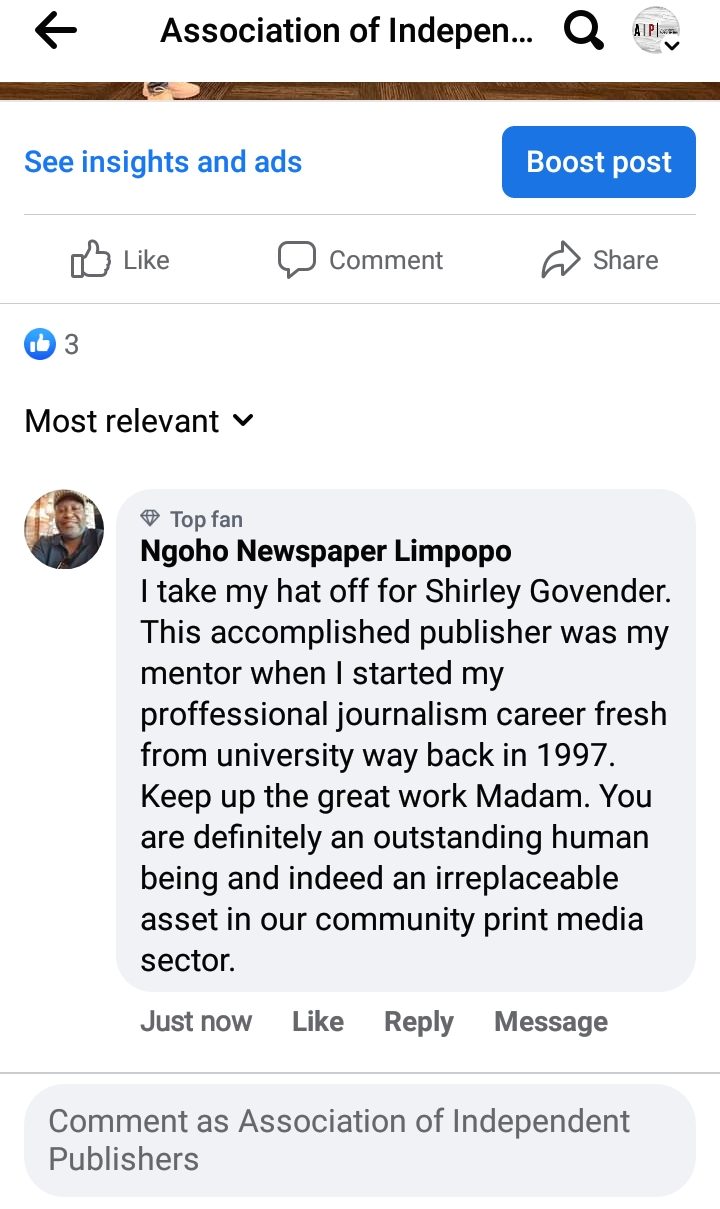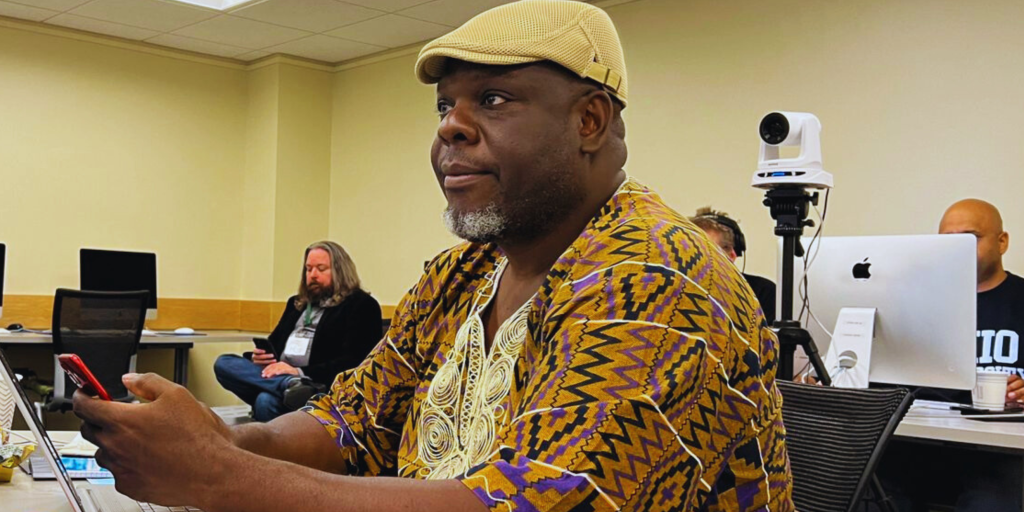Day 4 – AIP-Ohio University Programme | The LION, The Budget and LaBantu: Sustainability stories

“I take my hat off for Shirley Govender,” Phumudzo Makharamedzha commented on Facebook below the link to Govender’s presentation on Xenor Projects at the EW Scripps School of Journalism.
“This accomplished publisher was my mentor when I started my professional journalism career fresh from university way back in 1997. Keep up the great work Madam. You are definitely an outstanding human being and indeed an irreplaceable asset in our community print media sector.”
In the lead-up to the trip to Ohio, AIP chair Mbali Dhlomo requested that the programme give each of the South African delegates an opportunity to introduce their business.
And so it came to pass that two publishers stepped forward in the hour after lunch each day. In this report on the fourth day of the AIP trip to Ohio, we’re putting the South African publishers’ presentations first.
Govender’s presentation of the history of her three newspapers was a clear, detailed and honest presentation of the challenges the 31-year-old business has faced, the innovative solutions they found and some ideas of new routes they are considering exploring.
“This US trip has come when it is really needed and I am so thankful to be here,” she said.
“Everything is about the greater good. I was born for this. I don’t know how to do anything else. I don’t think I’ll ever retire, they’ll be about to switch the machines off and I’ll still be editing something.”

Peter Luhanga’s presentation on Iliso LaBantu Newspaper centred on his theme of always “doing the right thing” through groundbreaking grassroots journalism.
Luhanga shared his expansive vision, which starts “In this age of algorithms and AI reinforcing media feedback loops, we believe print is one of the best ways to break down the echo chamber constructed around readers of news and counter the phenomenon of misinformation distributed by unethical platforms.”
As a practical example, Luhanga showed his heartrending report on “A day in the life of a municipal sewerage worker”.
Luhanga also showed delegates a video where he was interviewed for telling the story of then-18-year-old Siyamthanda Mtyeku who lived in a one-room shack with four others – and got 7 distinctions in matric.
Luhanga reflected on the fact that 100% of their current revenue comes from advertising and they need to create sustainability models.
“If our committed advertorial clients who have been supporting us for the past eight years pull the plug, we would need to fold but would never die.”
The Budget and the LION
That is exactly the need that LION Publishers aims to fill, with the acronym standing for Local Independent Online News.
Earlier in the day, Chris Krewson had inspired delegates with his story of how LION Publishers offers teaching, resources and a supportive community for independent entrepreneurs who are working to build sustainable businesses.
LION Publishers supports more than 425 independent news sites in the U.S. and Canada.
“Our members get access to expert- and peer-led training, coaching and funding opportunities, a vibrant community of fellow founders, discounts to our conferences and other events, and the chance to be nationally recognized for their work. We also offer a discounted membership for aspiring entrepreneurs.”
LION Publishers has established a News Entrepreneur Academy which offers courses on a variety of topics on revenue generation, operations and journalistic impact.
LION’s Sustainability Audits and Funding program offers “a comprehensive process for LION members to identify and respond constructively to roadblocks to sustainability within their organisations”.
Krewson believes we are not facing a crisis in journalism but “a crisis in the business of journalism”. In fact, he asserts, there’s more journalism than ever before in history.
Some of the solutions Krewson’s crew have tried include a Facebook-funded two-year program where revenue-generating employees were inserted into about a dozen newsrooms across the United States.
“About a third were successful, and two-thirds did just ok, these are high-risk businesses,” he said.
The organisation has a number of initiatives which are based on a membership model, communicating using SLACK.
“We use a funnel logic when it comes to revenue and action, and deploy this in our own systems,” Krewson pointed out.
“We have 4500 who get our newsletter, then there are 1800 on our SLACK group and we convert that to 450 paid-up members.”
Benefits include free access to CANVA Plus for publishers, access to media lawyers and a concept called the Tiny News Collective.
Later after lunch, Professor Bill Reader told the gathering that despite the fact that he doesn’t like to use the “unique” because it is overused, in the case of The Budget, he says he is willing to make an exception “because it is truly unique”.
“It is a fascinating example of community journalism that is in one way tied to a specific place and in another way tied to a specific culture,” Reader said.
Milo Miller is the publisher of The Budget, which is the largest newspaper serving the Amish and Mennonites worldwide.
The Sugarcreek Ohio-based weekly newspaper has a Local and a National edition.
The Budget story began in 1890 when printer John C. Miller realised that Sugarcreek needed its own newspaper. Now the little town is known as “The little Switzerland of Ohio” and for its oddities like the World’s Largest Cuckoo clock.

A reader who has moved west wrote back and told him what was happening in his new Amish community and John Miller put the letter in The Budget. By the end of the year he had 35 “scribes” in 15 states writing letters to him.
Currently, the 52-page national edition has 1 100 “scribes” from Amish and Mennonite communities in 40 states in the US and beyond. The scribes go through a rigorous application process that includes church oversight and background checks.
Letters are sent in by post, fax or email and are reviewed by a copyeditor who has been working on the paper for 40 years. They are then typeset and proofread. The newspapers’ printers do the printing and deliver the newspapers for posting to subscribers and retail outlets.
Many readers regard the letters as if they were sent by friends and family.
“They don’t want violence, they don’t want sex, they don’t want politics and we put our audience first.”
Although Milo Miller and his team are not Amish, their mantra is “It’s their newspaper, we are just privileged to publish it for them”.
The Budget is one of the few newspapers whose print subscriptions are growing, he says. It is also one of the few newspaper businesses that has closed down its website.
In about 2007, The Budget set up a local news website and in 2016 decided to expand it into a national site. They noticed their circulation numbers started going down and heard from some readers that they didn’t want The Budget online at all, so on 31 December 2018 they pulled the plug on the digital edition. Circulation gradually started creeping back up and now there are over 20 000 subscribers to the national edition, of which 9000 are in Ohio.
Although The Budget company does well with advertising, it has diversified by acquiring and starting a number of other publications, including an Amish business directory, “The Diary of the Old Order Churches” and the programme preview for the “Horse Progress Days”, an annual event. They also sell harmonicas through their database of 98,000 subscribers.
While it is a mouthpiece for the Amish way of life, the business of journalism is taken very seriously.
“There are no sweetheart deals, the rate card is always in use and everybody sees the same rate card,” said Miller.
“it’s the right thing to do – if you offer a deal how much do you value your own newspaper?”



